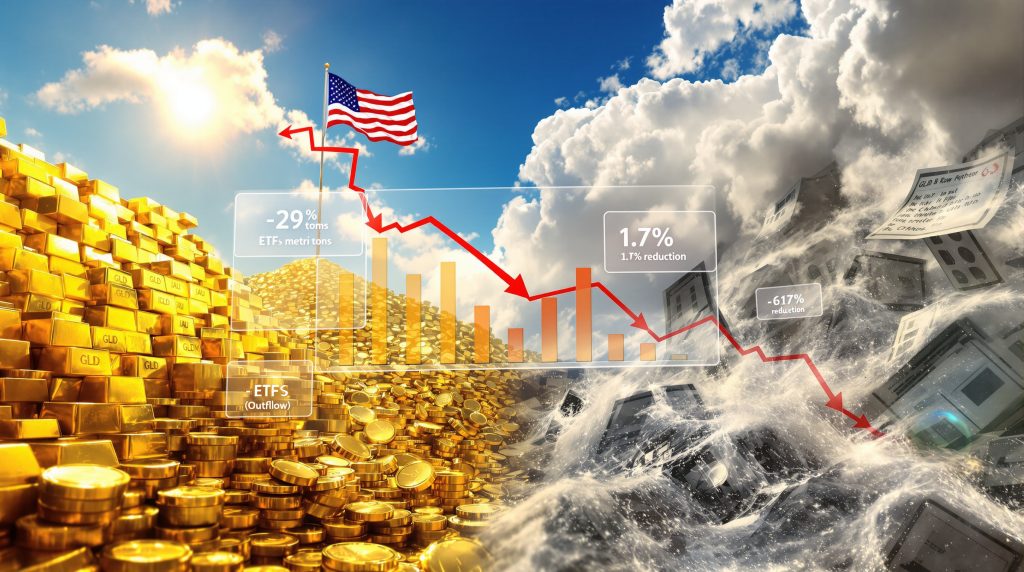What Triggered the Sudden Shift in American Gold ETF Investment Patterns?
The dramatic reversal in American gold ETF flows represents one of the most significant sentiment shifts in precious metals investing during 2025. After months of unprecedented capital inflows that helped drive gold market surge to historic highs above $4,350 per ounce, the American stock investors gold ETF exodus has begun in earnest as investors flee exchange-traded funds.
This reversal stems from multiple converging factors that created a perfect storm for momentum collapse. Gold experienced a devastating 9.5% decline over just seven trading days following its October peak, marking the largest drawdown of gold's 139.1% cyclical bull market over 24.5 months since early October 2023. The catalyst came on October 21st when gold suffered a brutal 5.3% single-day plunge that ranked as the 39th-largest down day in 54.8 years of modern gold trading.
Unlike previous market cycles where ETF outflows typically lag gold price corrections by several weeks or more, this time the capital flight began almost immediately. The three largest American gold ETFs – GLD, IAU, and GLDM – peaked their holdings simultaneously with gold highs analysis showing gold's $4,350 summit on October 20th, breaking decades of historical precedent where ETF buying would continue for weeks after gold topped.
What makes this reversal particularly striking is the psychological whiplash experienced by momentum-chasing investors. After months of relentless media coverage promoting gold's upward trajectory, the sudden price collapse shattered prevailing bullish narratives. Major financial outlets had been running what industry analysts described as near-constant gold coverage, with billionaire hedge fund managers publicly predicting much higher prices within six months.
How Significant Was the Pre-Reversal Gold ETF Buying Frenzy?
Record-Breaking Capital Inflows Throughout 2025
The scale of American investor participation in gold's rally was truly extraordinary. According to the World Gold Council's Q3 2025 Gold Demand Trends report, gold-ETF bullion demand skyrocketed 134.2% year-over-year to 221.7 metric tons, making it gold's fastest-growing demand category. This vastly outpaced bar-and-coin demand growth of 16.8% to 315.5 metric tons.
Q3 2025 American Gold ETF Performance:
| ETF | Quarterly Growth | Holdings Increase | Annual Management Fee |
|---|---|---|---|
| GLD | 6.3% | 60.3 metric tons | 0.40% |
| IAU | 8.9% | 39.2 metric tons | 0.25% |
| GLDM | 14.3% | 21.2 metric tons | 0.10% |
| Combined | 7.8% | 120.7 metric tons | Variable |
The dominance of American ETFs becomes clear when compared globally. While the three major American funds increased holdings by 120.7 metric tons, all other world gold ETFs combined managed only 101.0 metric tons of growth – a remarkable concentration of investment demand.
October's Frenzied Acceleration Phase
The buying intensity reached fever pitch during October's first three weeks. These same three ETFs added another 3.8% or 62.9 metric tons in holdings during this compressed timeframe. To put this acceleration in perspective, this represented nearly half of Q3's entire 120.7 metric tons of growth compressed into roughly one-sixth the time period.
This acceleration coincided with gold's additional 12.9% rally in October's opening weeks, pushing the metal to an extreme 33.0% extension above its 200-day moving average – described by technical gold analysis experts as the most extreme overbought condition in gold's modern trading history.
Market Concentration and Global Impact
The market power concentration among American ETFs cannot be overstated. GLD and IAU alone commanded 38.9% of all gold held by all world gold ETFs by Q3's end, making their collective behaviour a critical driver of global gold prices. This concentration means American investor sentiment effectively moves the entire global gold market.
GLDM's rapid growth trajectory deserves particular attention. Despite launching only in June 2018, this newer fund's ultra-low 0.10% annual fee – merely one-quarter of GLD's 0.40% fee – has positioned it to cannibalise demand from higher-cost alternatives. Its 14.3% quarterly growth rate significantly outpaced both established competitors.
What Market Conditions Created the Perfect Storm for Reversal?
Extreme Technical Overbought Territory
Gold's technical positioning became increasingly precarious throughout October 2025. The metal's 33.0% extension above its 200-day moving average represented unprecedented territory that historically signals unsustainable price extension. This extreme overbought condition created significant vulnerability to any negative catalyst.
Technical analysts had been warning about mounting risks throughout the rally's later stages. The combination of parabolic price action and extreme positioning created what market veterans recognised as classic blow-off top characteristics – conditions that historically precede sharp reversals.
Media Euphoria and Sentiment Extremes
The psychological environment surrounding gold reached euphoric levels rarely seen in precious metals markets. Major financial media outlets including CNBC, Bloomberg, and the Wall Street Journal were running what observers described as near-constant gold coverage with increasingly bullish commentary.
Key Sentiment Indicators:
• Billionaire hedge fund managers publicly predicting much higher gold prices within six months
• Financial media frequency of gold reporting increasing dramatically
• Near-universal bullish sentiment among mainstream financial commentators
• Growing retail investor FOMO (fear of missing out) psychology
• Contrarian warnings being dismissed or generating negative feedback
This sentiment backdrop created conditions where few investors were prepared for gold's inherent volatility to reassert itself. The concentration of bullish opinion left markets particularly vulnerable to sentiment reversals.
Momentum-Chasing Psychology Reaches Critical Mass
The rapid acceleration of gold purchases in October represented classic momentum-chasing behaviour taken to extremes. American stock investors, accustomed to equity market momentum strategies, applied similar approaches to gold investing without fully appreciating precious metals' different volatility characteristics.
This momentum-driven demand proved "brittle" in nature – when the fast-rallying price action wobbled and reversed, hot-money demand quickly evaporated. The speed of sentiment change caught many investors off-guard, particularly those who had recently entered positions during gold's final surge phase.
How Are American Investors Currently Exiting Gold ETF Positions?
Unprecedented Speed of Capital Flight
The exodus pattern differs markedly from all historical precedents. Rather than the typical lag period where ETF outflows follow gold price declines by several weeks, the American stock investors gold ETF exodus began immediately after gold's peak. The three major ETFs have experienced six consecutive trading days of holdings declines – the longest streak since November 2024.
This immediate reversal suggests a fundamental change in investor behaviour patterns. Previous gold market corrections allowed for gradual sentiment adjustment, but the extreme overbought conditions and violent initial price decline triggered immediate selling pressure.
Current Outflow Magnitude and Trajectory
Recent ETF Outflow Statistics:
• Total holdings reduction: 1.7% or 29.8 metric tons
• Largest single-week outflow: 1.5% or 26.6 metric tons
• Percentage of recent gains unwound: Approximately 20%
• Consecutive decline days: Six trading sessions
These outflows represent only the initial phase of what could become a more substantial unwinding. To contextualise the scale, the current 29.8 metric tons of outflows represents roughly one-fifth of the frenzied 149.6 metric tons of holdings built during September and October's majority.
Mechanical Selling Dynamics and ETF Structure
The structure of physically-backed gold ETFs creates mechanical selling pressure during redemption periods. When investors sell ETF shares faster than gold itself declines, fund managers must liquidate physical gold bullion to maintain proper tracking and meet redemption demands.
This forced selling adds downward pressure on gold prices beyond what fundamental supply-demand dynamics would suggest. Each metric ton of ETF outflows requires equivalent physical gold sales, creating a self-reinforcing cycle where ETF selling pressures gold prices lower, potentially triggering additional investor exits.
Which Gold ETFs Face Greatest Vulnerability During Continued Stress?
Fee Structure Impact on Investor Retention
GLDM's ultra-low 0.10% annual fee structure positions it as potentially more resilient during market stress periods. Cost-conscious investors may prefer maintaining positions in the most economical vehicle rather than crystallising losses. Conversely, GLD's higher 0.40% fee structure could accelerate outflows as investors reassess cost-benefit ratios during volatile periods.
ETF Fee Comparison and Vulnerability Assessment:
| ETF | Annual Fee | Fee Advantage | Stress Vulnerability |
|---|---|---|---|
| GLDM | 0.10% | Highest | Lowest (cost advantage) |
| IAU | 0.25% | Moderate | Moderate |
| GLD | 0.40% | Lowest | Highest (cost disadvantage) |
Market Share Dynamics During Volatile Periods
The concentration of market power among American ETFs creates systemic risks during stress periods. Their combined 38.9% share of global gold ETF holdings means sustained outflows could create cascading effects across worldwide gold markets.
Historical patterns suggest that during market stress, investors often consolidate positions into lower-cost, more liquid vehicles. This dynamic could benefit GLDM and IAU at GLD's expense, even within a broader outflow environment.
What Historical Patterns Suggest About Future Gold ETF Flows?
Cyclical Bull Market Correction Precedents
Analysis of historical gold bull markets reveals consistent correction patterns that may apply to current conditions. The ten largest historical gold bulls averaged subsequent corrections of 20.8% over approximately 2.1 months. If this pattern repeats, gold could decline toward $3,480 – a level that would likely trigger additional ETF outflows.
This historical precedent suggests the current 9.5% decline represents only the initial phase of a potentially larger correction cycle. Such declines typically unfold in waves, with interim bounces followed by renewed selling pressure until technical and sentiment extremes are fully unwound.
ETF Amplification Effects in Both Directions
Gold ETFs create amplification effects that work in both directions. During bull markets, ETF buying forces fund managers to purchase additional physical gold, adding upward price pressure beyond underlying demand. During bear markets, the reverse occurs with mechanical selling pressure.
Historical ETF Impact Patterns:
• Bull market phases: ETF buying amplifies upward momentum by 15-25%
• Bear market phases: ETF selling amplifies downward momentum by similar margins
• Sentiment reversals: ETF flows can reverse 2-4 weeks faster than fundamental factors
• Recovery phases: ETF buying often leads fundamental demand recovery by 1-2 months
How Might Continued ETF Outflows Impact Gold Prices?
Mechanical Selling Pressure Calculations
The mathematics of ETF selling pressure are straightforward but potentially devastating. American investors built up 149.6 metric tons of additional holdings from late August through October's peak. Each metric ton of outflows requires equivalent physical gold sales by ETF managers.
Potential Selling Pressure Scenarios:
• Scenario 1 (25% unwind): 37.4 metric tons additional selling pressure
• Scenario 2 (50% unwind): 74.8 metric tons additional selling pressure
• Scenario 3 (100% roundtrip): 149.6 metric tons total selling pressure
• Current progress: 29.8 metric tons already sold (20% of potential)
Feedback Loop Risks and Cascading Effects
The relationship between ETF outflows and gold prices creates potential for negative feedback loops that could accelerate beyond fundamental justification. As prices decline due to ETF selling, technical stop-losses trigger, momentum strategies reverse, and additional investors choose to exit.
This cascading effect can drive prices below levels justified by underlying supply-demand fundamentals. Such overshoots typically create attractive buying opportunities for fundamental investors, but the timing and magnitude remain unpredictable.
What Factors Could Reverse Current ETF Exodus Trends?
Technical Support Levels and Stabilisation Points
Gold's ability to hold key technical support levels around $4,000 could help stabilise investor sentiment and slow ETF outflow momentum. A successful test of these levels might encourage value-oriented buying and demonstrate that the selling pressure has reached equilibrium.
Critical Technical Levels to Monitor:
• $4,000: Psychological round number support
• $3,850: 200-day moving average convergence zone
• $3,650: Previous resistance turned support level
• $3,480: Historical 20% correction target
Macroeconomic Catalyst Potential
Several macroeconomic developments could quickly reverse investor sentiment toward gold and stem ETF outflows. Furthermore, many of the underlying factors that drove gold's initial rally remain intact despite the technical correction.
Potential Reversal Catalysts:
• Renewed geopolitical tensions in Eastern Europe or Middle East
• Unexpected inflation data exceeding Federal Reserve targets
• Federal Reserve policy pivot toward more accommodative stance
• Currency crisis in major developed economy
• Banking sector stress requiring central bank intervention
The underlying economic conditions that drove gold's initial rally – including elevated geopolitical risks, currency debasement concerns, and central bank monetary policies – remain largely intact despite the technical correction.
Strategic Positioning for Continued ETF Volatility
Risk Management Approaches for Current Holders
Investors maintaining gold safe haven insights positions during this volatile period should implement sophisticated risk management strategies. Traditional buy-and-hold approaches may prove inadequate given gold's amplified volatility and the mechanical nature of ETF selling pressure.
Recommended Risk Management Techniques:
• Trailing stop-losses: Set 8-12% below recent highs to protect gains while allowing recovery
• Position sizing: Reduce exposure to no more than 5-10% of total portfolio during volatile periods
• Diversification: Spread exposure across multiple ETFs with different fee structures
• Dollar-cost averaging: Gradual accumulation during decline phases rather than lump-sum purchases
Tactical Allocation Strategies
Rather than concentrating investments in single gold ETF vehicles, sophisticated investors might consider spreading exposure across funds with different characteristics and trading behaviours. This approach helps mitigate fund-specific risks during market stress periods.
Strategic Allocation Framework:
| Strategy | GLDM Allocation | IAU Allocation | GLD Allocation | Rationale |
|---|---|---|---|---|
| Cost-Focused | 50% | 30% | 20% | Minimise fees during volatility |
| Liquidity-Focused | 20% | 30% | 50% | Prioritise trading flexibility |
| Balanced | 35% | 35% | 30% | Optimise cost and liquidity |
Long-Term Implications of the 2025 Gold ETF Reversal
Structural Changes in Gold Market Dynamics
The current American stock investors gold ETF exodus represents more than simple profit-taking behaviour. It demonstrates fundamental changes in how precious metals markets operate in an era of increased ETF participation and algorithmic trading strategies.
The speed and intensity of the reversal suggest that American retail investor behaviour has become increasingly influential in gold price discovery mechanisms. This creates both opportunities and risks for long-term gold investors who must now account for these amplified volatility patterns.
Implications for Future Bull Market Cycles
For gold's longer-term trajectory, this correction may prove beneficial by resetting overbought technical conditions and establishing more sustainable price levels for future advance phases. However, the precedent of immediate ETF selling following price peaks may fundamentally alter gold's traditional correction patterns.
Looking ahead, the gold price forecast suggests that despite current volatility, structural factors supporting precious metals remain robust.
Key Structural Implications:
• ETF flows may become more synchronised with price movements going forward
• Correction phases may unfold faster but potentially with greater magnitude
• Recovery phases may depend more heavily on technical factors than fundamental drivers
• American investor sentiment may become even more critical for global gold trends
Market Evolution and Adaptation Requirements
The ultimate test will be whether this exodus represents a temporary correction within an ongoing secular bull market or signals a more fundamental shift in investor appetite for gold exposure. Historical precedents suggest the former, but the unprecedented nature of recent price action and ETF behaviour patterns make definitive predictions challenging.
Successful gold investors will need to adapt their strategies to account for these new market dynamics, incorporating both traditional fundamental analysis and modern technical understanding of ETF-driven price movements. The integration of momentum-chasing American stock investors into gold markets has permanently altered precious metals investing.
The convergence of extreme technical overbought conditions, euphoric sentiment levels, and concentrated ETF market power created the perfect storm for 2025's dramatic reversal. While painful for recent buyers, this correction may ultimately strengthen gold's long-term bull market trajectory by purging speculative excess and resetting conditions for sustainable future growth.
Understanding these dynamics will be crucial for investors navigating gold's evolution from a traditional store-of-value asset to a modern financial instrument increasingly influenced by ETF mechanics and algorithmic trading strategies.
Looking to Capitalise on Gold Market Volatility?
Discovery Alert's proprietary Discovery IQ model delivers instant notifications on significant ASX mineral discoveries, including precious metals opportunities that could benefit from gold's market dynamics and investor appetite shifts. Explore how historic mineral discoveries have generated substantial returns during volatile market conditions, positioning investors ahead of major announcements whilst others focus solely on ETF movements.



